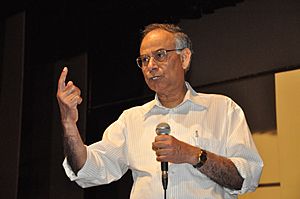Ananda Mohan Chakrabarty facts for kids
Quick facts for kids
Ananda Mohan Chakrabarty
|
|
|---|---|

Ananda Mohan Chakrabarty at Science City, Kolkata on 8 Nov. 2009
|
|
| Born | 4 April 1938 Sainthia, Bengal Presidency, British India
|
| Died | 10 July 2020 (aged 82) |
| Nationality | Indian |
| Alma mater | University of Calcutta |
| Known for | Genetically engineering a Pseudomonas bacterium |
| Scientific career | |
| Fields | Microbiology |
Ananda Mohan Chakrabarty (born April 4, 1938 – died July 10, 2020) was an Indian American microbiologist. He was a brilliant scientist and researcher. He became famous for his work with genetic engineering. He created a special living thing using plasmid transfer. This led to a very important court case called Diamond v. Chakrabarty. This case changed how new inventions could be protected by law.
Contents
His Early Life
Ananda Chakrabarty was born in Sainthia, India, on April 4, 1938. His friends and colleagues often called him "Al." He went to Sainthia High School. Then he studied at Ramakrishna Mission Vidyamandira. After that, he attended St. Xavier's College in Calcutta. He earned his PhD degree from the University of Calcutta in 1965.
Creating the Oil-Eating Bacteria
In 1971, Professor Chakrabarty worked for General Electric. He used genetic engineering to create a new type of bacteria. This special bacteria could "eat" oil. People called it the "oil-eating bacteria."
A Special New Microbe
Before his work, scientists knew about four kinds of bacteria that could break down oil. But when these bacteria were in an oil spill, they would compete with each other. This limited how much oil they could clean up. The special instructions (called genes) for breaking down oil were on tiny loops of DNA called plasmids. These plasmids could move between different bacteria.
Professor Chakrabarty found a way to combine these plasmids. He used UV light to make the genes stick together. This created a new, stable type of bacteria. It was named Pseudomonas putida. This new microbe could eat oil much faster than the older types. It could digest about two-thirds of the oil in a typical spill.
The Big Patent Case
Professor Chakrabarty wanted to get a patent for his new bacteria. A patent is like a special permission. It gives the inventor the right to make, use, or sell their invention. This was the first time someone tried to patent a genetically modified organism in the U.S.
At first, the Patent Office said no. They thought that living things could not be patented. But Sidney A. Diamond, who was in charge of patents, took the case to the Supreme Court. The Supreme Court heard the case on March 17, 1980. They made their decision on June 16, 1980. The Court said that Professor Chakrabarty's bacteria could be patented.
This important decision, known as Diamond v. Chakrabarty, changed a lot of things. It opened the door for many other patents on genetically modified micro-organisms. It also made Professor Chakrabarty famous around the world.
Fighting Cancer with Bacteria
Later in his career, Professor Chakrabarty's lab studied how certain bacterial proteins could help fight cancer. These proteins, like azurin, were known for helping bacteria move energy. But he found they might also help stop cancer cells from growing.
He also started companies to develop new medicines. In 2001, he founded CDG Therapeutics. In 2008, he co-founded Amrita Therapeutics Ltd. These companies worked on using bacterial products to create new treatments for cancer and other health problems.
His Important Roles
Professor Chakrabarty was a respected professor at the University of Illinois at Chicago College of Medicine. He also advised many important groups. These included judges, governments, and the UN. He helped create the International Centre for Genetic Engineering and Biotechnology. He was also a member of its science advisory group.
He served on committees for the NIH. He was part of the Board on Biology for the National Academy of Sciences. He also advised the Stockholm Environment Institute in Sweden. He was on the science boards of many universities and research centers.
In 2007, the government of India gave him the Padma Shri award. This is a high honor for his work in genetic engineering technology.
Images for kids


